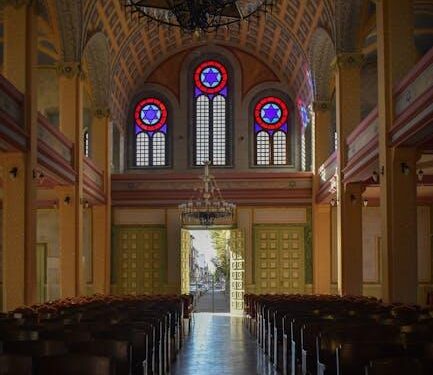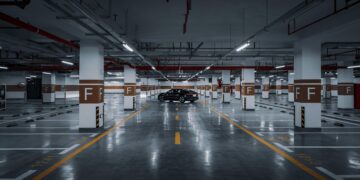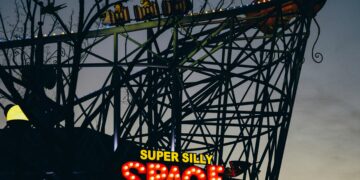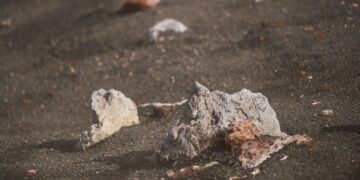Table of Contents
Introduction: Crafting Crestmont – A World Both Imagined and Real
The setting of the Netflix series 13 Reasons Why is a masterfully constructed duality, a place that exists simultaneously in the realms of fiction and tangible reality. It is, by design, a deliberately generic “Anytown, USA,” engineered to universalize the show’s challenging themes of suicide, bullying, and sexual assault. Yet, it is also a highly specific and atmospheric collection of Northern California locations, chosen for their unique, moody authenticity that grounds the drama in a palpable world. This report will deconstruct this duality, exploring the setting on four distinct levels: the fictional geography of the show’s world, the real-world filming locations that gave it life, the artistic intent behind its design, and the complex socio-economic impact of the production on its host communities.
The first clue to this intentional ambiguity lies in the viewer’s initial confusion over the show’s primary location name. Is it Crestmont or Evergreen? The names are used interchangeably and with little clarification, a point of frequent discussion among fans.1 This is not a continuity error but the first layer of a sophisticated world-building strategy. The series inherits the name “Crestmont” from Jay Asher’s 2007 source novel, but in a significant departure, it largely relegates that name to a single, nostalgic location: the movie theater where protagonists Hannah Baker and Clay Jensen shared their most hopeful moments.3 This report will demonstrate that the setting of
13 Reasons Why is far more than a simple backdrop; it is an active and essential component of the narrative, a carefully crafted environment where the lines between a universal story and a specific place are purposefully and powerfully blurred.
Section 1: The Fictional Geography of a Tragedy
The on-screen, narrative setting of 13 Reasons Why is defined by a calculated vagueness. This ambiguity is not a flaw but a core creative strategy designed to strip the location of a unique identity, thereby forcing the audience to confront the show’s themes as universal problems rather than as a story confined to one specific town.
1.1 What’s in a Name? Deconstructing “Crestmont” and “Evergreen County”
Within the world of the show, the name of the town where the students of Liberty High live is never explicitly and consistently stated, leading to a deliberate confusion that has been a subject of fan debate since the series premiered.1 The name “Crestmont,” which served as the setting for the original novel, is present in the series but is almost exclusively used to refer to the Crestmont Movie Theatre, a place of employment for Hannah and Clay and the site of some of their most positive interactions.3 This specific application of the name detaches it from the broader town identity.
In contrast, the name “Evergreen” appears on more official and functional items within the show’s universe. A subpoena served to the character Bryce Walker lists his address as being in “Evergreen County, CA,” and the name “Evergreen” is also seen on the side of a public bus.1 This suggests that “Evergreen” is the larger municipal or county designation. Fan communities on platforms like Reddit have dissected these clues, with many concluding that the most logical explanation is that Crestmont is a smaller town or neighborhood located within the larger, fictional Evergreen County.1
This creative choice to introduce a second name, “Evergreen,” and relegate the novel’s original name, “Crestmont,” to a single symbolic location is a significant departure from the source material. By doing so, the show’s creators symbolically quarantine the idea of “Crestmont” as a place of nostalgia and what might have been. The name becomes associated with the brief, happy past that is irrevocably lost, while the colder, more bureaucratic “Evergreen County” represents the grim reality of the present where the tragic consequences of the story unfold.
1.2 The “Anytown, USA” Strategy: Universalizing Trauma
The ambiguity surrounding the town’s name serves a profound thematic purpose. By avoiding a consistent and clear name, the creators fostered a sense of placelessness, a key element of their narrative strategy.7 Production sources have confirmed that this vague setting was “meant to show a small town deemed safe by its citizens that could be relatable to all viewers”.7 This approach is designed to prevent the audience from creating psychological distance from the difficult subject matter. It reinforces the core message that the events depicted—the “snowball effect” of bullying, the trauma of sexual assault, and the tragedy of teen suicide—are not problems confined to a singular, troubled place.8
This strategy ensures that the story of Liberty High could be the story of any high school. Production designer Diane Lederman noted that this effect was successful, recounting that viewers from across the United States, from New Jersey to Long Island, believed the show was filmed in their own hometowns because the visuals felt so familiar.9 This sense of familiarity is crucial; it underscores the idea that such tragedies can and do happen anywhere, even in a community that appears charming, quaint, and safe on the surface.9 The placelessness of “Crestmont” or “Evergreen” makes it impossible for viewers to dismiss the story with an “it couldn’t happen here” mentality.
Section 2: A Location Scout’s Map to 13 Reasons Why
While the fictional setting of 13 Reasons Why is intentionally vague, its physical creation is rooted in the very real and specific landscapes of Northern California’s Bay Area. The production team primarily utilized locations across three key cities—Vallejo, Sebastopol, and San Rafael—to construct the tangible world of Crestmont and Evergreen County.11 This section serves as a definitive guide, mapping the show’s iconic locations to their real-world counterparts.
2.1 Vallejo: The Commercial and Social Heart of Crestmont
The city of Vallejo, particularly its historic downtown, served as the primary stand-in for the commercial and social center of the fictional town. Production designer Diane Lederman specifically chose Vallejo because its “wonderful old Main Street with a lot of empty storefronts” provided a blank canvas.13 The production took over and transformed several of these spaces to create key settings.7
- Monet’s Café: The central hangout for the show’s teenage characters was created within the former City Lights building at 415 Virginia Street.11 The production team built out the coffee shop in this previously empty space, giving them complete creative control.13
- The Crestmont Theatre: The iconic movie theater where Hannah and Clay worked and bonded was another custom build, constructed in an empty storefront at 333 Georgia Street.5
- Baker’s Drug Store: The Baker family’s struggling business was brought to life at 419 Georgia Street (some sources also cite 435 Georgia Street).11 The set was so realistic that it famously caused confusion for locals, especially after a real pharmacy opened just a block away during filming.17 The verisimilitude was such that Google Maps’ Street View cars captured images of the storefront with its fictional “Baker’s Drug Store” sign still in place.14
- Mare Island Studios: The nerve center of the entire production was located on Mare Island, a former naval base in Vallejo.11 Within a massive 100,000-square-foot warehouse, the crew built sprawling soundstages for many of the show’s most critical interior sets, including exact replicas of the Liberty High School hallways and most of the main characters’ bedrooms.13
2.2 Sebastopol’s Analy High: The Architecture of Liberty High
The exterior and initial interior shots of the fictional Liberty High School were filmed at Analy High School, located at 6950 Analy Avenue in Sebastopol.11 The production integrated authentic details from the real school into the show, including its mascot, the Tigers, and its blue paw print logo.14
The demands of a long-running television series, however, made continuous filming at a functioning school impossible. Once the school year began, access was limited, prompting a remarkable feat of production design. The crew meticulously recreated the school’s hallways, classrooms, and administrative offices on the Mare Island soundstages.11 These replicas were so convincing that they were indistinguishable from the real location footage used in the first two episodes.19 The school’s gymnasium was a separate project entirely; the team located a derelict gym on Mare Island and completely renovated it, stripping the floors, painting the walls, and adding custom banners and logos to create the “tiger’s den” and give the fictional school a sense of history.13
2.3 The Suburban Maze: San Rafael, Larkspur, and the Homes of the Cast
The residential streets and suburban homes of the characters were primarily filmed in Marin County, with San Rafael and Larkspur providing the backdrop for the characters’ private lives.
- Clay Jensen’s House: The Jensen family home is a real private residence located at 231 Bayview Street in San Rafael.11 The location gained a measure of fame when fans discovered that Google Maps had inadvertently captured images of the film crew, production trucks, and actor Dylan Minnette (his face blurred) outside the house during a mapping run.21 The home’s real-world Zillow estimate of $1.5 million also provides an interesting socioeconomic context for the Jensen family, suggesting an upper-middle-class standing despite the show’s lack of focus on their finances.23
- Hannah Baker’s Houses: The series cleverly used two different houses for the Baker family to visually represent their declining financial stability due to their failing business.24
- The first, larger house, seen in early flashbacks such as the party where rumors about Hannah began, is located at 316 G Street in San Rafael.14
- The second, smaller house, where the family lived at the time of Hannah’s death, is at 2 Diane Lane in Larkspur.14 The real-life owners of this home, Gillian Cassel and David Ripperton, shared that the filming process was an immersive experience, with the crew removing all of their personal furniture and redecorating the rooms completely for each shoot.25 For the second season, to improve logistical convenience, an exact replica of this house was constructed on a soundstage, with the owners providing the blueprints.25
- Other key residences, including the homes of Bryce Walker and Tony Padilla, were also scouted and filmed in San Rafael, cementing the city as the primary suburban setting for the series.14
2.4 The Broader Landscape: Vistas, Parks, and Pivotal Moments
Beyond the central hubs of Vallejo and San Rafael, the production utilized a wide range of Northern California locations to capture specific, memorable scenes.
- The Overlook: The iconic vista where Clay sits on a bench overlooking two bridges is a hill above Eckley Pier in Crockett. The bridges featured are the Carquinez Bridge and the Alfred Zampa Memorial Bridge.11
- The Rock-Climbing Scene: The tense and pivotal conversation between Tony and Clay in episode eight takes place among the unique sandstone formations of Rock City in Mount Diablo State Park.11
- The Cemetery: Hannah’s burial site and subsequent scenes were filmed at the serene Fernwood Cemetery in Mill Valley.11
- The Courthouse: For the legal drama of the second season, the production used the historic Contra Costa County Courthouse in the city of Martinez.27
- The “Walplex”: The fictional big-box chain store that puts the Baker’s Drug Store out of business was filmed at a Friedman’s Home Improvement store in Petaluma.6
Table 2.1: Key Filming Locations and Their Real-World Addresses
The following table consolidates the key fictional locations from 13 Reasons Why with their real-world counterparts, providing a clear and accessible reference guide.
| Fictional Location | Real-World Location/Building | Address | City | Narrative Significance |
| Liberty High School | Analy High School | 6950 Analy Ave | Sebastopol | The central hub of the characters’ lives and the primary setting for the bullying and social conflicts. |
| Liberty High (Interiors) | Mare Island Studios | N/A (Soundstage) | Vallejo | Replicas of Analy High used for controlled, long-term filming. |
| Monet’s Café | Former City Lights Building | 415 Virginia St | Vallejo | The main social gathering spot for the teens outside of school. |
| The Crestmont Theatre | Empty Storefront | 333 Georgia St | Vallejo | Where Hannah and Clay worked; a symbol of their friendship and lost potential. |
| Baker’s Drug Store | Empty Storefront | 419-435 Georgia St | Vallejo | The Baker family business; a site of family stress and a source for Hannah’s suicide method in the novel. |
| Clay Jensen’s House | Private Residence | 231 Bayview St | San Rafael | Clay’s private world and the primary location where he listens to the tapes. |
| Hannah Baker’s House (Final) | Private Residence | 2 Diane Lane | Larkspur | The site of Hannah’s suicide and a symbol of her family’s financial and emotional struggles. |
| Hannah’s First House (Party) | Private Residence | 316 G Street | San Rafael | Location of a key early party where rumors about Hannah began. |
| Bridge Overlook | Hill above Eckley Pier | N/A | Crockett | An iconic spot for Clay’s solitary reflection while listening to the tapes. |
| Rock Climbing Scene | Rock City, Mount Diablo State Park | N/A | Clayton | The setting for Tony and Clay’s confrontational bonding moment. |
| Cemetery | Fernwood Cemetery | N/A | Mill Valley | Hannah’s final resting place. |
| Courthouse | Contra Costa County Courthouse | 725 Court St | Martinez | The setting for the lawsuit against the school in Season 2. |
Section 3: The Art of World-Building: Production Design and Thematic Resonance
The selection and design of the filming locations were not merely logistical choices but fundamental artistic decisions that shaped the show’s tone, themes, and emotional impact. The creative team, led by showrunner Brian Yorkey and production designer Diane Lederman, developed a sophisticated visual language that used the physical environment to represent the characters’ complex internal landscapes. This approach reveals a fascinating paradox: the production used a highly specific, atmospheric location to create a universally relatable “Anytown.” The specificity of the Northern California setting, far from making it unrelatable, grounded the fictional world in a tangible reality that made the universal themes of pain and trauma feel more potent and believable.
3.1 The Northern California Vision: A Moody, Palm-Free Reality
The decision to film in the San Francisco Bay Area was a deliberate and foundational choice. Showrunner Brian Yorkey was adamant about creating a visual world that felt authentic and distinct from the sun-drenched aesthetic of typical Southern California teen dramas. He famously held a strict “no palm trees” rule, going so far as to order reshoots for a driving sequence when a single palm tree appeared on screen.29 Yorkey’s vision was for a setting that more closely resembled his native Pacific Northwest, a place that would feel more familiar and real to a broader American audience.29
This vision was executed by production designer Diane Lederman, who selected the region specifically for its “evocative landscape… with its mountains, hills and rolling fog”.13 This natural environment provided a “moody and mysterious quality” that was essential for mirroring the show’s dark and contemplative tone.13 The physical atmosphere of the location—the fog, the muted light, the rolling hills—became a form of pathetic fallacy, visually echoing the confusion, depression, and emotional turmoil of the characters.
3.2 Painting with Emotion: Strategic Use of Color and Light
Beyond the macro choice of landscape, Lederman’s team employed a highly controlled color palette to subconsciously guide the audience’s emotional experience and delineate character psychologies.19 This use of color and light served to externalize the internal states of the characters, enriching the storytelling beyond dialogue and performance.
- Color Palette: A controlled color scheme was integral to the production design.19 Blue, a color often used by impressionist painters to convey mood and emotion, was the predominant color for the entire series. It was especially prominent in settings tied to Clay Jensen and at Liberty High, visually linking his character to the institution and reflecting his pervasive sense of melancholy and confusion.19 In contrast, Hannah Baker’s defining color was purple. This was chosen because it felt like a “teenage girl color, but it’s more mature than pink,” and it represented her “deep-seated soulfulness,” intelligence, and the “mystery” surrounding her story.19
- Lighting as a Timeline Cue: One of the most effective visual strategies was the use of lighting to differentiate between the show’s dual timelines. Scenes set in the past, during Hannah’s life, were consistently lit with a warm, almost nostalgic glow. This created a sense of a brighter, more hopeful time that has been lost. Conversely, scenes set in the present, as Clay navigates the aftermath of her death, were rendered in a cool, harsh, and desaturated light.19 This constant, subtle visual cue helped the audience navigate the complex narrative structure while reinforcing the emotional chasm between the past and the present.
3.3 The Psychology of Personal Space: Designing the Teenage Bedroom
The characters’ bedrooms were treated as sacred spaces for character development, meticulously designed to be reflections of their inner lives, histories, and personalities.30 Lederman operated on the philosophy that “nobody is dropped out of the sky,” meaning each room had to feel lived-in and layered with personal history.30 This was a collaborative process involving deep research and conversations with the actors themselves. For example, Dylan Minnette was instrumental in choosing the music posters for Clay’s room, ensuring they reflected the character’s interest in older, alternative music, a detail that Brian Yorkey felt was crucial to Clay’s individuality.30
These spaces were filled with artifacts that told a story of transition from childhood to adulthood. Jessica’s room contained stuffed animals and dolls, while Clay’s featured his beloved robots and an astronomy poster.30 This visual juxtaposition of childhood innocence with the emerging pressures of adolescence made the traumatic events they experienced all the more harrowing. Seeing Jessica have to confess her sexual assault to her father in her childhood bedroom, or watching Clay listen to the devastating tapes surrounded by the relics of his own youth, powerfully underscored the tragedy of innocence lost.30
3.4 The Map as a Narrative Engine: Experiencing Emotional Geography
The physical setting of 13 Reasons Why is not a passive backdrop; it is an active engine of the plot, structured by Hannah’s cassette tapes and the accompanying map.4 Clay’s journey through the town is the central narrative device of the first season. This forces him, and by extension the audience, to re-contextualize seemingly ordinary places—a park playground, a coffee shop, a liquor store, a street corner—as sites of profound trauma and significance.
This structure transforms the town into an emotional landscape. The physical act of moving from one location to the next mirrors the psychological process of uncovering the truth, piece by painful piece. This makes the setting integral to the show’s core theme of the “snowball effect,” the idea expressed by both Hannah in the show and author Jay Asher in his personal book signings, that “everything affects everything”.8 Each location on the map is a link in a chain of events, and by visiting them, Clay is forced to understand the interconnectedness that led to the final tragedy.
Section 4: The Real-World Ripple Effect: Community, Controversy, and Commerce
The production of 13 Reasons Why was not contained to its soundstages; it had a significant and complex impact on the Northern California communities that served as its real-world set. This relationship exemplifies the modern “creative economy,” where the substantial financial benefits of hosting a major production are weighed against the social and cultural disruptions it can bring. The communities gained revenue and a new form of cultural cachet, but in return, they ceded some control over their public spaces and became inextricably linked to the show’s brand, including its significant controversies.
4.1 The “13 Reasons Why” Effect: Economic Impact and Film Tourism
The decision to film in the Bay Area brought a significant economic boon to the region. Film Mare Island Studios reports that Paramount Television projects, including 13 Reasons Why and the film Bumblebee, spent more than $41 million in Solano County alone.33 This infusion of capital was felt directly by local institutions. The West Sonoma County High School District, which faced a budget crisis, received nearly $500,000 over the show’s four seasons in lease payments, staff overtime wages, and infrastructure improvements for the use of the Analy High School campus.29
Beyond direct spending, the show’s global popularity spurred a wave of film tourism. Numerous online guides, fan videos, and travel articles emerged, directing fans to the real-world locations of Monet’s, the Crestmont Theatre, and the characters’ homes.6 This phenomenon created a new cultural identity for parts of Vallejo, San Rafael, and Sebastopol, turning previously anonymous storefronts and suburban streets into destinations for a global audience and providing an ongoing, indirect economic benefit to local businesses.
4.2 Filming in the Face of Disaster: The California Wildfires
The production’s commitment to the authentic Northern California landscape exposed it to the region’s increasing environmental vulnerabilities. The moody fog and evocative hills that were so artistically desirable came with the very real risk of wildfires, which became an unscripted antagonist in the production’s story.
On at least two separate occasions, filming was forced to a halt due to the hazardous air quality caused by massive regional blazes. The October 2017 Northern California wildfires disrupted production on Season 2, and the devastating Camp Fire in November 2018 similarly paused filming for Season 3 in Vallejo.7 These were not minor inconveniences but large-scale natural disasters that required the production to cease operations for days to ensure the safety of the cast and crew. This created a powerful irony: the natural landscape, so carefully selected to enhance the fictional drama, introduced its own real-world peril into the production process, highlighting that in the 21st century, choosing a location is also choosing its environmental risks.
4.3 A Welcome Disruption? Local Reception and Controversies
For the most part, the local reception to the filming was positive, driven by the economic benefits and the excitement of hosting a major Hollywood production. The city of Vallejo, described by production staff as an economically “depressed town,” was particularly welcoming.13 Open casting calls for extras drew thousands of hopeful local residents, eager to be part of the phenomenon.38
However, the presence of a high-profile show dealing with such sensitive and controversial subject matter was not without friction. When filming took place in Martinez for Season 2, some local residents expressed mixed feelings, balancing their fascination with the filmmaking process with genuine concern over the show’s dark themes and potential impact on young people.27
A more direct, albeit minor, controversy arose in September 2019 when the production filmed scenes in Oakland’s Joaquin Miller Park at a time when the park was officially closed to the public due to high fire danger.40 While the production followed all city protocols, including paying for a dedicated fire inspector to be on-site, some parkgoers perceived it as preferential treatment, questioning why a film crew was allowed access when the general public was not.41 These instances illustrate the complex and sometimes delicate negotiation that occurs between a production’s logistical needs and a community’s daily life, public access, and cultural values.
Conclusion: The Enduring Geography of Crestmont
The setting of 13 Reasons Why is a triumph of deliberate, multi-layered world-building. The analysis of its creation and function reveals a sophisticated understanding of how place informs narrative. The show’s creators masterfully balanced the thematic need for a universal, relatable “Anytown, USA” with the artistic desire for a specific, atmospheric, and authentic physical space. They achieved this not through contradiction, but through a powerful synthesis: the hyper-specific, moody reality of Northern California was the very tool that made the universal themes of adolescent pain feel so terrifyingly immediate and real.
The legacy of the series is now etched not just in its controversial narrative or its impact on cultural conversations about mental health, but in the physical landscape of the San Francisco Bay Area. By transforming real towns into a fictional world, the production created an enduring cultural landmark. The show has forever linked the tragic story of Hannah Baker and the fictional world of Crestmont to the tangible streets, storefronts, and vistas of Vallejo, Sebastopol, and San Rafael. In doing so, it has crafted a powerful and visitable geography where fiction and reality permanently intersect, ensuring that the world of 13 Reasons Why will remain a destination for fans and a case study for cultural analysts for years to come.
Works cited
- So is it Crestmont or Evergreen County? : r/13ReasonsWhy – Reddit, accessed on August 6, 2025, https://www.reddit.com/r/13ReasonsWhy/comments/8lgtfw/so_is_it_crestmont_or_evergreen_county/
- What do you think the name of the town is in the show? : r/13ReasonsWhy – Reddit, accessed on August 6, 2025, https://www.reddit.com/r/13ReasonsWhy/comments/ihdmpy/what_do_you_think_the_name_of_the_town_is_in_the/
- 13 Reasons Why – Wikipedia, accessed on August 6, 2025, https://en.wikipedia.org/wiki/13_Reasons_Why
- Thirteen Reasons Why Setting – Shmoop, accessed on August 6, 2025, https://www.shmoop.com/study-guides/thirteen-reasons-why/setting.html
- 13 Reasons Why at 333 Georgia Street – filming location – SCEEN IT, accessed on August 6, 2025, https://www.sceen-it.com/sceen/2254/13-Reasons-Why/333-Georgia-Street
- 13 REASONS Why Filming Locations | THEN & NOW – YouTube, accessed on August 6, 2025, https://www.youtube.com/watch?v=elTMwkiH7a4
- 13 Reasons Why: Where The Show Was Filmed (& Where It’s Set) – Screen Rant, accessed on August 6, 2025, https://screenrant.com/13-reasons-why-filming-locations-setting-california/
- 13 Reasons Why Themes | Symbol & Motif Dive – Storyboard That, accessed on August 6, 2025, https://www.storyboardthat.com/lesson-plans/13-reasons-why-by-jay-asher/theme-symbol-motif
- Diane Lederman Takes Us Behind the Scenes Of the Production …, accessed on August 6, 2025, https://www.awardsdaily.com/2017/05/04/interview-diane-lederman/
- What are the setting, conflicts, plot, and themes in Thirteen Reasons Why by Jay Asher?, accessed on August 6, 2025, https://www.enotes.com/topics/thirteen-reasons-why/questions/setting-conflicts-plot-thirteen-reasons-why-389193
- “13 Reasons Why” Filming Locations – Where Was “13 Reasons …, accessed on August 6, 2025, https://www.seventeen.com/celebrity/movies-tv/a47369/13-reasons-why-filming-locations/
- en.wikipedia.org, accessed on August 6, 2025, https://en.wikipedia.org/wiki/13_Reasons_Why#:~:text=Filming%20for%20the%20series%20took,Netflix%20on%20March%2031%2C%202017.
- 13 Reasons Why’s Production Designer on Netflix’s Daring new Teen Drama – The Credits, accessed on August 6, 2025, https://www.motionpictures.org/2017/03/13-reasons-whys-production-designer-netflixs-daring-new-teen-drama/
- Filming Locations Guide: Where was 13 Reasons Why filmed? – Atlas of Wonders, accessed on August 6, 2025, https://www.atlasofwonders.com/2017/03/13-reasons-why-filming-locations.html
- 13 Reasons Why Film Locations, accessed on August 6, 2025, https://globalfilmlocations.net/2017/04/20/13-reasons-why-film-locations/
- ’13 Reasons Why’ filming locations in the Bay Area – Laredo Morning Times, accessed on August 6, 2025, https://www.lmtonline.com/tv/slideshow/13-Reasons-Why-filming-locations-in-the-Bay-Area-147775.php
- 13 Reasons Why Film Locations In Vallejo, CA, accessed on August 6, 2025, https://www.visitvallejo.com/film-office/13-reasons-why-film-locations-in-vallejo-ca
- Film Locations for 13 Reasons Why in Vallejo : r/bayarea – Reddit, accessed on August 6, 2025, https://www.reddit.com/r/bayarea/comments/65f6iw/film_locations_for_13_reasons_why_in_vallejo/
- Production Designer Diane Lederman Discusses Her Work On “13 Reasons Why” – LA 411, accessed on August 6, 2025, https://la411.com/blog/post/production-designer-diane-lederman-discusses-her-work-on-13-reasons-why
- Where was 13 Reasons Why filmed? – Giggster, accessed on August 6, 2025, https://giggster.com/guide/movie-location/where-was-13-reasons-why-filmed
- Did Google Maps Accidentally Capture “13 Reasons Why” While They Were Filming?, accessed on August 6, 2025, https://www.seventeen.com/celebrity/movies-tv/news/a46444/google-maps-might-have-caught-dylan-minnette-outside-clay-jensens-house/
- ’13 Reasons Why’: Somebody Might’ve Found Clay Jensen on Google Maps – TheWrap, accessed on August 6, 2025, https://www.thewrap.com/13-reasons-why-somebody-mightve-found-clay-jensen-on-google-maps/
- I can’t be the only one thinking Clay and Justin have a super cool room, right? – Reddit, accessed on August 6, 2025, https://www.reddit.com/r/13ReasonsWhy/comments/gzlljy/i_cant_be_the_only_one_thinking_clay_and_justin/
- Does anybody know why Hannah has two different homes in the tv show? : r/13ReasonsWhy – Reddit, accessed on August 6, 2025, https://www.reddit.com/r/13ReasonsWhy/comments/72bexq/does_anybody_know_why_hannah_has_two_different/
- Meet the couple living in Hannah Baker’s house – Redwood Bark, accessed on August 6, 2025, https://redwoodbark.org/39503/culture/lifestyles/meet-couple-living-hannah-bakers-house/
- ’13 Reasons Why’ filming locations in the Bay Area – SFGATE, accessed on August 6, 2025, https://www.sfgate.com/tv/slideshow/13-Reasons-Why-filming-locations-in-the-Bay-Area-147775.php
- Teen Drama ’13 Reasons Why’ Takes Over Martinez Streets – CBS San Francisco, accessed on August 6, 2025, https://www.cbsnews.com/sanfrancisco/news/teen-drama-13-reasons-why-takes-over-martinez-streets/
- Martinez Streets Closed For Filming Of Netflix Teen Drama – YouTube, accessed on August 6, 2025, https://www.youtube.com/watch?v=v_3ULkinLk8
- 13 Reasons Why – Location Managers Guild International, accessed on August 6, 2025, https://locationmanagers.org/13-reasons-why/
- How 13 Reasons Why’s Sets Made Authentic Teens – Screen Rant, accessed on August 6, 2025, https://screenrant.com/how-13-reasons-why-created-authentic-teenage-experience/
- Elements Of Literature – PBworks, accessed on August 6, 2025, http://th1rteenr3asonswhy.pbworks.com/Elements-Of-Literature
- 13 Reasons Why showrunner explains most controversial choices – Entertainment Weekly, accessed on August 6, 2025, https://ew.com/tv/2017/05/12/13-reasons-why-controversy-brian-yorkey/
- Solano County Film History — Visit Vallejo, accessed on August 6, 2025, https://www.visitvallejo.com/film-office/solano-county-feature-film-history
- Your Guide to the Bay Area Filming Locations of 13 Reasons Why, accessed on August 6, 2025, https://www.bayarea.com/things-to-do/13-reasons-why/
- Flames and smoke near film sets are real enough – Los Angeles Times – eNewspaper, accessed on August 6, 2025, https://enewspaper.latimes.com/infinity/article_share.aspx?guid=576b9758-2101-4a73-91e0-77aef96529fc&fbclid=IwAR1AkIK_Y70JAAxnASTt5h7HqHgSUnm-aejJx3P0LV-RpEBu_8S4A_m-og8
- ’13 Reasons Why’ and Other Projects Resume Production After California Wildfire Shutdown, accessed on August 6, 2025, https://sg.news.yahoo.com/13-reasons-why-other-projects-211442684.html
- ’13 Reasons Why’ pauses production due to California wildfires – Entertainment Weekly, accessed on August 6, 2025, https://ew.com/tv/2017/10/11/13-reasons-why-production-halted-california-wildfires/
- Vallejo Teens Turn Out For ’13 Reasons Why’ Casting Call – CBS San Francisco, accessed on August 6, 2025, https://www.cbsnews.com/sanfrancisco/news/vallejo-teens-13-reasons-why-casting-call/
- Hundreds Of Vallejo Teens Respond To Open Casting Call For ’13 Reasons Why’, accessed on August 6, 2025, https://www.youtube.com/watch?v=CG4qHz-3XEE
- ’13 Reasons Why’ Crews Shoot At Oakland Park That’s Closed Due To Fire Danger, accessed on August 6, 2025, https://www.youtube.com/watch?v=vRhIU5UjuRI
- ’13 Reasons Why’ Films At Oakland Park That’s Closed Due To Fire Danger – CBS News, accessed on August 6, 2025, https://www.cbsnews.com/sanfrancisco/news/13-reasons-why-films-at-oakland-park-thats-closed-due-to-fire-danger/






